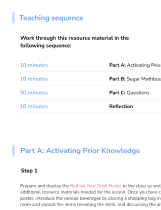Lesson summary
In this lesson, students will learn new skills that will allow them to critically consider the messages conveyed in visual advertising.
They will note their first impressions of a printed advertisement, then take part in a jigsaw classroom activity to build their knowledge of persuasive techniques used in advertising. Students will then apply their new understanding to their analysis the printed ad. They will use their new skills to subvert the message of a printed advertisement using words or images, then engage in a reflection activity to consider how applicable the learning in the lesson is to their everyday lives.
We’ve taken elements of this lesson and adapted them for remote learning. You can find these activities here and here.
Learning intentions:
Students will...
- understand how printed advertisements use visual language to persuade
Success criteria:
Students can...
- describe how visual language is used to create a message in a printed advertisement
- edit the elements of a visual advertisement to subvert the marketing messages of the product being advertised
Lesson guides and printables
Curriculum links
Select your curriculum from the options below.
Lesson details
Curriculum mapping
Australian Curriculum content description:
English, Years 9 & 10
Year 9
- Interpret, analyse and evaluate how different perspectives of issue, event, situation, individuals or groups are constructed to serve specific purposes in texts (ACELY1742)
- Explore and explain the combinations of language and visual choices that authors make to present information, opinions and perspectives in different texts (ACELY1745)
- Create imaginative, informative and persuasive texts that present a point of view and advance or illustrate arguments, including texts that integrate visual, print and/or audio features (ACELY1746)
Year 10
- Identify and analyse implicit or explicit values, beliefs and assumptions in texts and how these are influenced by purposes and likely audiences (ACELY1752)
- Use comprehension strategies to compare and contrast information within and between texts, identifying and analysing embedded perspectives, and evaluating supporting evidence (ACELY1754)
- Create sustained texts, including texts that combine specific digital or media content, for imaginative, informative, or persuasive purposes that reflect upon challenging and complex issues (ACELY1756)
Relevant parts of Year 9 achievement standards: Students analyse the ways that text structures can be manipulated for effect. They analyse and explain how images, vocabulary choices and language features distinguish the work of individual authors. They evaluate and integrate ideas and information from texts to form their own interpretations. In creating texts, students demonstrate how manipulating language features and images can create innovative texts.
Relevant parts of Year 10 achievement standards: Students evaluate how text structures can be used in innovative ways by different authors. They explain how the choice of language features, images and vocabulary contributes to the development of individual style. Students create a wide range of texts to articulate complex ideas.
This lesson is part of the wider unit of work SugarByHalf – English – Years 9-10
Time required: 90 mins
Level of teacher scaffolding: Medium – facilitate student movement around the classroom and guide class discussions
To view our NZ Curriculum alignment click here.
Resources required
- Student Worksheets – one copy per student
- Class set of magazines or newspapers that feature advertising of food products
- Example advertisement – printed in colour, one copy per student
- Visual language factsheets:
- Web-enabled devices (optional)
Additional info
These lessons were developed in partnership with SugarByHalf. SugarByHalf promotes action to reduce sugar-related diseases so that we can live better, stronger and healthier lives.
Their message is simple: to reduce added sugar consumption by half. Eating too much added sugar is a key driver of serious health problems including obesity, type 2 diabetes, heart disease, tooth decay, dementia and mental health conditions. A poor diet also puts children behind their peers, affecting brain development, sleep and ability to learn. Poor diet choices ultimately mean that this generation of children could be the first in modern history to live shorter lives than their parents.
Much of the added sugar in our diet comes from the processed foods and drinks we consume. On average, we consume 14-16 teaspoons of added sugar per day. Teenagers consume more than 20 teaspoons per day. The World Health Organisation says we should limit our daily added sugar intake to 6 teaspoons for good health. To put that in perspective, there are 4 grams of sugar in one teaspoon. If something has 20 grams of sugar, that's 5 teaspoons of sugar.
This English lesson focuses on developing the skills and knowledge students need to critically consider messages about food and drink they are exposed to, thereby equipping them to be able to make healthy choices.
Talking about health
- Be mindful of students who may experience weight stigma. Some students may be sensitive to conversations around weight, body size or shape. Terms including obesity, weight issues, weight-problem and fat can be stigmatising for some people because they assign blame. It is important to note individual preferences around language vary. Research has shown using the terms ‘weight’, ‘weight gain’, ‘healthy weight’, ‘unhealthy weight’, and ‘high BMI’ are preferred as better alternatives.
- Be mindful about how you use the word ‘diet’. We recommend focussing students on the positive impacts of healthy nutrition and healthy lifestyles which help us to have stronger bodies and minds, feel good and sleep well.
- Steer students away from any focus on appearances by communicating that appearance does not determine your worth. We recommend the fact sheets from the Butterfly Foundation on body image tips.
- Avoid using labels such as obese or diabetic. Refer to people living with diabetes, people living with cancer, people with high BMI etc.


Welcome back!
Don't have an account yet?
Log in with:
Create your free Cool.org account.
Many of our resources are free, with an option to upgrade to Cool+ for premium content.
Already have an account?
Sign up with:
By signing up you accept Cool.org's Terms and Conditions(Opens in new tab) and Privacy Policy(Opens in new tab).